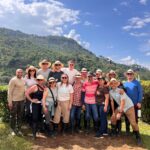
Tom and Subhankar embarked on a journey to Colombia with the EVS team to document the journey of coffee from “Bean to Cup.” As we know, Nespresso maintains strict quality control by exclusively roasting, grinding, and encapsulating all their coffee at their factories in Switzerland.
In this blog, we provide a detailed look at the incredible journey of a coffee bean—from its earliest stage at harvesting to the green bean form in which it gets exported. We were both deeply moved and humbled by witnessing the sheer dedication, hard work, and passion that goes into producing just one cup of delicious Nespresso coffee. Join us on this journey, and we hope you enjoy reading!

Cultivating: A Journey Through the Coffee Farms of Jardín, Colombia
Our recent trip to the charming town of Jardín in Colombia was an eye-opening journey into the world of coffee cultivation. Situated at a breathtaking 1,870 meters above sea level, the lush, high-altitude terrain, rich soil, healthy rainfall, and an average temperature of 18°C, makes Jardín a perfect paradise for growing coffee. Here, we experienced the full cycle of coffee production — from the selection of seeds to the harvest of the cherries — and it was nothing short of magical.
The process begins with the seed of a coffee cherry, which may look like a small, unassuming fruit but holds the potential for something extraordinary. The farmers in Jardín carefully select the right seeds, ensuring they come from a healthy tree with a solid genetic foundation. This seed contains an embryo at its center, a genetic blueprint that will eventually shape the coffee plant.
Farmers can either purchase certified seeds or reuse seeds from trees that have previously yielded high-quality coffee. In either case, the seeds are nurtured in sandy, well-draining soil to promote healthy growth and prevent root diseases. The soil helps prevent waterlogging and ensures the roots receive enough oxygen, which is crucial for the plants’ development.
For the first three months, the seedlings are kept in nurseries at least 80 cm above the ground, covered to protect them from direct sunlight and rain. At this stage, the seedlings begin to grow their first 2-3 leaves, called “chapola.” Afterward, these young plants are carefully transplanted into polybags filled with fertile soil, where they will spend the next 6-8 months growing stronger and healthier.
Once the plants reach about 30 cm in height, they are ready for their final destination — the coffee farm. The farmers carefully plant them in rows, making sure to space them out evenly. This spacing is crucial as the trees need room to grow and access nutrients. The coffee plants are spread out across the farm, usually in plots that are aligned along the same altitude line, at a distance of about 1.5 meters and 2 meters up and down.
At this stage, the farmers begin the important task of weeding regularly to ensure that the plants receive the necessary nutrients and aren’t competing with invasive plants. These early stages are critical as they set the foundation for the trees’ future productivity. If cared for properly, these coffee trees will continue to produce cherries for about 20 years.

The First Signs of Coffee: Flowers and Cherries
Around 12 months after being planted outside, the coffee plants begin to show their first signs of life — small, delicate flowers appear. These flowers eventually transform into green cherries. However, the weather can play a major role in this process. Too much rain or unfavorable weather conditions can damage the flowers, resulting in a smaller harvest.
It takes about 3 to 4 years from planting the seeds for the coffee trees to bear fruit. However, the farm’s management plays a crucial role. By maintaining trees properly, ensuring fertile, healthy soil, and clearing weeds, farmers can create the right conditions for plants to flourish. Every 4-5 years, or when more than 20% of the trees die off in one plot, farmers must prune or cut down trees to maintain a healthy crop.
Nespresso’s Role in Supporting Sustainable Coffee Farming
Sustainability is at the heart of Jardín’s coffee farming community. Nespresso’s AAA program has been pivotal in helping farmers like those in Jardín improve their cultivation practices. Nespresso supports farmers by sending agronomists, tools, soil analysis, and other ways. In this way, farmers can produce high-quality coffee that is also sustainable and yields better results over time.
The partnership with Nespresso not only improves the farmers’ livelihoods but also helps them grow coffee that is better for the environment. With Nespresso’s support, these farmers can access resources that allow them to work smarter, produce better coffee, and create a future that is both economically and environmentally sustainable.
Cherry De-pulping, Fermenting, Washing, and Drying
Once the cherries are harvested, to maintain freshness, they must be depulped the same day. This step removes the outer fruit, revealing the coffee beans inside. After de-pulping, the beans undergo fermentation for 12–18 hours. This is a very important step as fermentation time can affect caffeine levels.
Once fermentation is complete, the beans are washed to remove any remaining mucilage before being sun-dried for 4 to 5 days. The unique temperature and humidity of Jardin create ideal conditions for producing high-quality coffee. Farmers who have the right equipment can manage this entire process on their farms. Otherwise, the cherries must be transported to the Central Mill for further processing.

Harvesting: The Physically Demanding Yet Rewarding Task
The coffee harvest is an intensive process that requires patience, skill, and hard work. Coffee is typically harvested once a year. However, in some countries, like Colombia, there are two harvests per year, one around March to April and another from September to October.
On the farms of Jardín, such as the one owned by Hernan, which spans 4 hectares (2 hectares of coffee plants and 2 hectares dedicated to banana, avocado, and other fruits), the harvest season is a busy time. Hernan’s team consists of 3-4 people who work from dawn to dusk, picking only the ripe cherries by hand. They can collect around 50 kg of cherries each on a good day.
Working on the steep slopes of the coffee farm with a bucket tied to their waists, the harvesters navigate the terrain with great skill. The process is physically demanding, and the weather can make it even more challenging, as the harvest period is also the rainy season. Many farmers help each other out or hire seasonal workers to manage the workload during harvest time.
When we asked Hernan’s son Andres which part of the coffee farming process he enjoyed the most, he smiled and said, “The harvesting.”
The Role of the Central Mill
The Central Mill plays a crucial role in ensuring consistency and quality in coffee production.
The benefits to the farmers: Once the farmer brings the cherries to the mill, a sample size of cherries is depulped, washed, and manually sorted to separate high-quality beans from defective ones—there can be up to 35 different types of defects in a single batch. If too many defects are found, the mill has the right to reject the cherries.
Once the percentage of good beans is determined, the total payout is calculated instantly. Farmers receive payment in cheques directly at the mill. By handling de-pulping and sorting, the mill allows farmers to focus more on harvesting. The mill also ferments, washes, and dries the beans on a larger scale. Once dried, the beans—now known as “parchments”—are sent to the Dry Mill for further processing.
The mill collects cherry pulps and turns them into compost, which farmers can take free of charge as fertilizer. The Central Mill we visited was exclusive to Nespresso AAA farmers, ensuring a consistent supply of top-tier coffee.

The Centralised Purchase Point
Once the beans have been fermented, washed, and dried, they become “parchment coffee.” At this stage, farmers can bring their beans to the Centralised Purchase Point, but only in parchment form—no cherries or wet beans are accepted.
The process:
- Farmers bring parchment coffee to the purchase point, where all bags are weighed.
- A small sample is taken from each bag, mixed, and tested.
- The first test measures humidity levels, which must be between 10-12%. If the beans don’t meet this standard, they are returned to the farmer.
- If the beans pass the humidity test, the parchment is removed, revealing green coffee beans.
- The green beans are then assessed for quality—defective beans are separated from the premium ones.
- Farmers are paid based on the percentage of high-quality beans in their batch.
- Nespresso only purchases the best green beans, while smaller or lower-grade beans are sold to other companies.
- The parchment beans are stored at the purchase point before being sent to the Dry Mill for further refinement.

The Dry Mill: Final Refinement Before Export
Both the Central Mill and the Purchase Points send parchment coffee to the Dry Mill, where the beans undergo their final transformation.
The process: Large-scale machinery removes the parchment layer, exposing the green beans. The beans are sorted by size, weight, and color to ensure uniformity. Quality control experts roast, grind, and cup-test sample beans to ensure flavor consistency. Green beans are then bagged, labeled with origin and quality grading, and prepared for export. Nespresso factories in Switzerland receive these beans for further testing before roasting and encapsulation.
By working closely with farmers, Central Mills, and Purchase Points, Nespresso ensures that only the best beans make it from the farm to your cup. It takes approximately 60 to 70 cherries to produce just one Nespresso capsule, making every step in this process crucial for delivering the perfect cup of coffee.
When I brewed my first cup after returning, it felt different. This small capsule had traveled so far— from farm to mill to cup, so many hands had shaped this moment—to reach me. That first sip tasted different, richer, knowing the journey behind it. Cheers to the next one!




